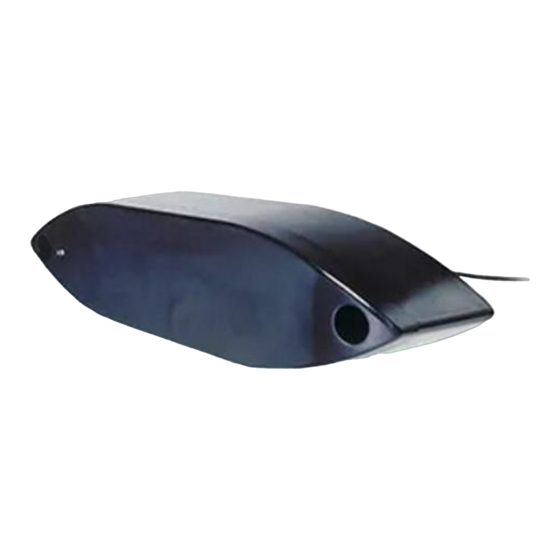
Advertisement
Quick Links
OWNER'S GUIDE & INSTALLATION INSTRUCTIONS
External Mount:
2-3kW with Temperature Sensor
Depth Transducer
Chirp Models: R109LH, R109LM, R109LHW, R409LWM,
R509LH, R509LM, R509LHW
Legacy Models: R99, R209, R309
Patent http://www.airmar.com/patent.html
Follow the precautions below for optimal
product performance and to reduce the risk of
property damage, personal injury, and/or death.
WARNING: Boats capable of speeds above 25kn
(29MPH)—You must follow these instructions for a
safe installation. For boats exceeding 35 kn. (40MPH)
or when the instructions cannot be met, mount an in-
hull transducer. At high speeds, the fairing and/or
transducer may break away from the boat.
WARNING: A stuffing tube is required. The stuffing tube
seals the hull forming a water-tight conduit for the cable.
WARNING: Always wear safety glasses, a dust mask,
and ear protection when installing.
WARNING: The fairing must be installed parallel to the
keel to ensure proper boat handling and water flow
under the transducer.
WARNING: Immediately check for leaks when the boat
is placed in the water. Do not leave the boat in the water
unchecked for more than three hours. Even a small leak
may allow considerable water to accumulate.
WARNING: Fiberglass hull—The transducer and
stuffing tube must be installed in solid fiberglass, not in
coring.
CAUTION: Aluminum hull—The stainless steel
hardware must be isolated from an aluminum hull to
prevent electrolytic corrosion.
CAUTION: Steel hull—Follow generally accepted
installation practices.
CAUTION: Never install a metal fitting on a vessel with
a positive ground system.
CAUTION: External mount only. The transducer will
overheat if it is mounted in a hull pocket.
CAUTION: Never pull, carry, or hold the transducer by
its cable. This may sever internal connections.
CAUTION: Never strike the transducer.
CAUTION: Tighten the nylon locking nuts with a torque
wrench using a force not exceeding 27N-m (20ft.-lb.).
Do not over tighten. It may crack the transducer and/or
crush the fairing.
CAUTION: Never use solvents. Cleaner, fuel, sealant,
paint, and other products may contain solvents that can
damage plastic parts, especially the transducer's face.
Record the information found on the cable tag for future reference.
Part No.:_________________Date___________Frequency________kHz
Remove
and discard
the packing
hardware.
Figure 1. Packing hardware
Copyright © 2007 Airmar Technology Corp.
IMPORTANT: Please read the instructions completely
before proceeding with the installation. These instructions
supersede any other instructions in your instrument manual
if they differ.
Applications
• Recommended for all hull materials
• Not recommended for hulls less than 9m (30') long
• Not recommended for stepped hulls. Mount an in-hull transducer
• Accommodates a deadrise angle up to 22
Unpacking & Pretest
Remove and discard the packing hardware (rod and 2 nuts)
(Figure 1). Connect the temperature function to the instrument
and check for the approximate air temperature. If there is no
reading or it is inaccurate, check the connections and test again. If
there is still a problem, return the product to your place of
purchase.
Tools & Materials
Safety glasses
Dust mask
Ear protection
Angle finder
Band saw (blade must be very sharp)
Rasp or power tool
Electric drill
Drill bits:
pilot hole
fiberglass, wood, or steel hull
aluminum hull
Permanent marker
Mild household detergent or weak solvent (such as alcohol)
Sandpaper
File (installation in a metal hull)
Marine sealant (suitable for below waterline)
Wrenches
Torque wrench
Grommet(s) (some installations)
Cable ties
Water-based anti-fouling paint (mandatory in salt water)
fairing
transducer
3mm or 1/8"
14mm or 9/16"
15mm or 9/16"
Advertisement

Subscribe to Our Youtube Channel
Summary of Contents for Airmar R99
- Page 1 Record the information found on the cable tag for future reference. 2-3kW with Temperature Sensor Part No.:_________________Date___________Frequency________kHz Depth Transducer Chirp Models: R109LH, R109LM, R109LHW, R409LWM, R509LH, R509LM, R509LHW Legacy Models: R99, R209, R309 Patent http://www.airmar.com/patent.html Remove fairing and discard the packing hardware.
- Page 2 22 ° max fence location of stuffing tube Figure 5. Fairing Figure 6. Fairing Figure 4. Cutting the fairing Copyright © 2005 Airmar Technology Corp. Copyright © 2007 - 2011 Airmar Technology Corp. Copyright © 2005 Airmar Technology Corp.
- Page 3 Figure 8. Threaded rod Figure 7. Bedding and installing the fairing and backing block (non-metal hull shown) Copyright © 2007 - 2015 Airmar Technology Corp. Copyright © 2007 Airmar Technology Corp. 7. The remaining section of the fairing with the cutting guide will sealant will adhere properly.
- Page 4 It is best not to leave the boat in the water unattended for more than 3 hours before email: sales@airmar-emea.com 35 Meadowbrook Drive, Milford, New Hampshire 03055-4613, USA • www.airmar.com Copyright © 2005 - 2018 Airmar Technology Corp. All rights reserved.















Need help?
Do you have a question about the R99 and is the answer not in the manual?
Questions and answers